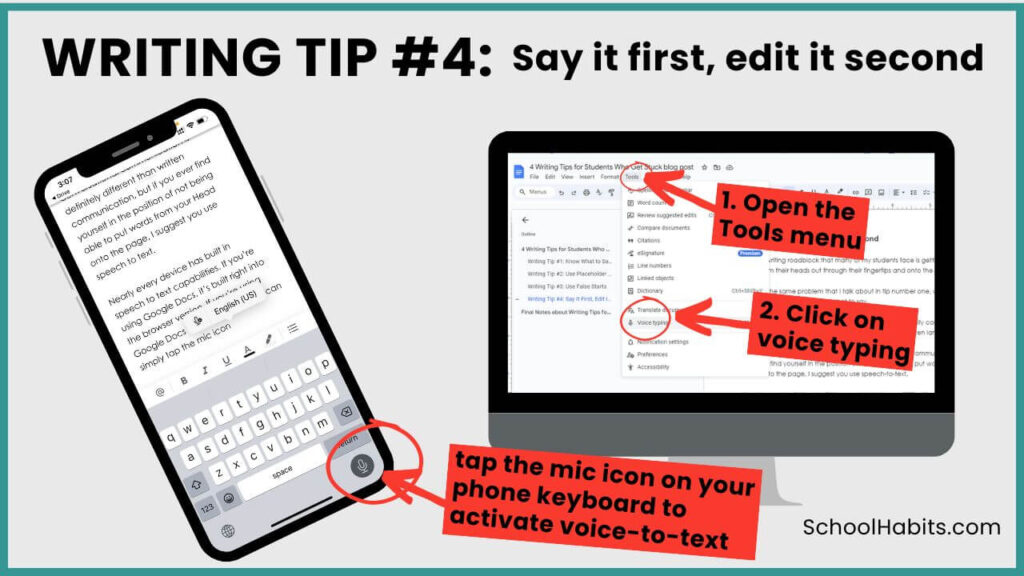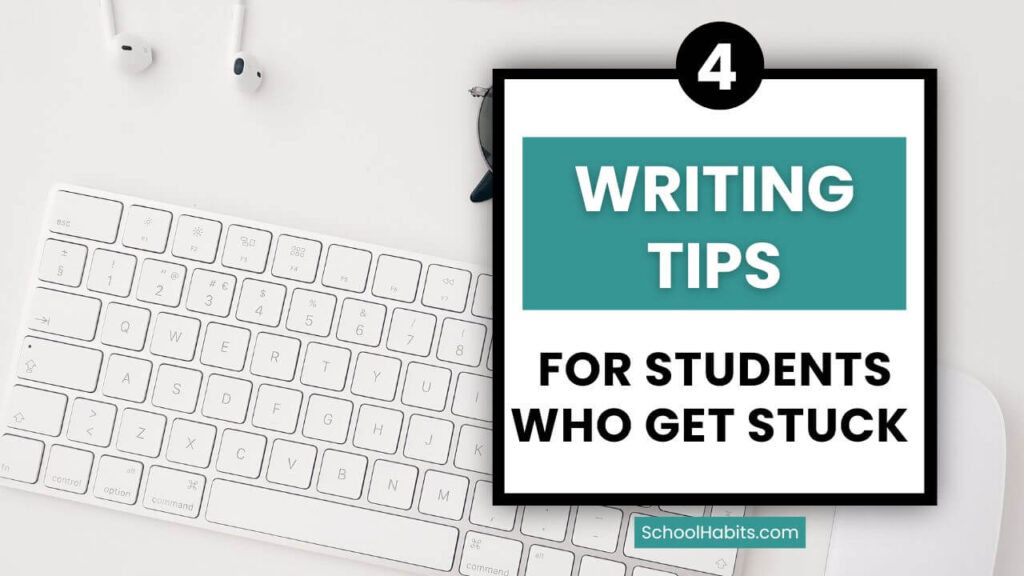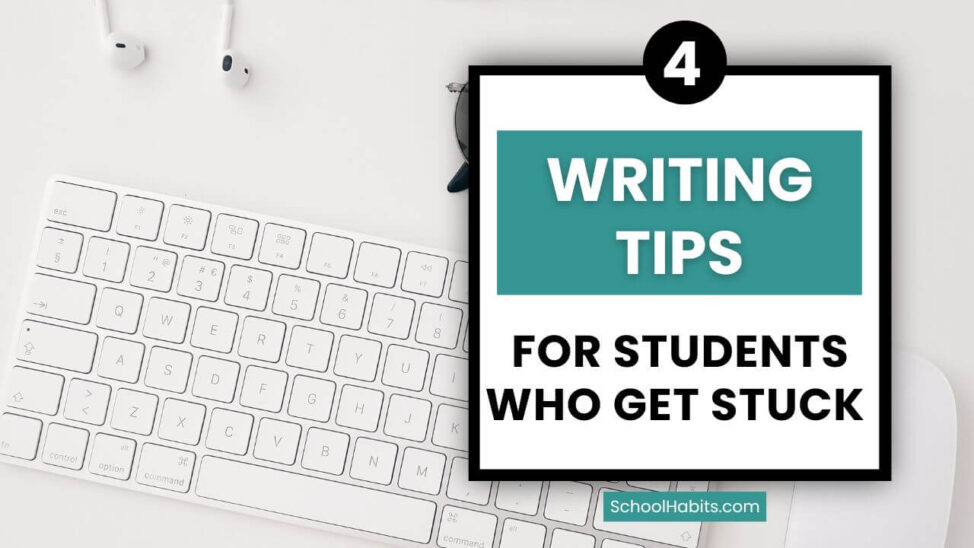By Katie Azevedo, M.Ed.
Writing essays or long open-response questions is one of the hardest parts of school for many students. The reason writing assignments are challenging is that so many other skills besides writing are required for the task.
Think about it: Writing a 5-paragraph essay requires organization, vocabulary, comprehension, expressive language capabilities, task initiation, critical thinking … and about 5 million more skills.
No wonder writing is hard.
In this blog post, I share four writing tips for students who get stuck while writing.
The writing tips are for the moments when:
- you’re staring at a blank page and you know don’t how to start
- you’ve written a few sentences but you feel like you have nothing else to say
- you have the sense that you “know what you want to say but just don’t know how to say it”
4 Writing Tips for Students Who Get Stuck
You may find that using just one of the writing tips below is enough to get you unstuck. Or, you may need to use a combination of the tips. It all comes down to how stuck you are.
Writing Tip #1: Know What to Say Before Figuring Out How to Say It
A common frustration my private clients tell me when we’re working on a writing assignment is that they “know what to say but just don’t know how to say it.”
Here’s the thing: This is almost always not true. In nearly every case, the student actually doesn’t know WHAT to say, but they interpret that as not knowing HOW to say it.
Let me say this clearly: You have to know what you’re trying to say in your writing first. What is it that you want to get across? What’s your point? What’s your message?
Only once you’re clear on what to say can you move on to figuring out HOW to say it.
Let’s look at an example. In fact, we are going to use a similar example throughout this blog post to demonstrate each of the 4 writing tips.
Book: The book we’re going to use as our ongoing example is A Separate Peace by John Knowles.
Thesis: We’re hypothetically writing an essay arguing that Gene’s jealousy of Finny begins as friendly competition but slowly turns toxic and obsessive. (Don’t know how to write a thesis statement? Here’s how.)
The Issue: You have a quote from the scene where Finny casually breaks the school swimming record without even trying, and Gene feels jealous. The quote is “Perhaps for that reason his accomplishment took root in my mind and grew rapidly in the darkness where I was forced to hide it.” You want to analyze the quote and connect it to your thesis but you claim you don’t know how to say this. (Psst: Here are my top tips for analyzing quotes in essays.)
The Writing Strategy: Think about what you actually want to say. Don’t focus on the how; focus on the what. If you were talking to a friend about the quote, what would you say to them? What would you say to convince your friend that the quote proves the thesis? Would you talk about the use of the word “root” and how that indicates Gine’s jealousy is growing? Would you talk about the word “darkness” and how that suggests that what Gene feels is becoming toxic?
Writing Tip #2: Use Placeholder Text
A helpful writing tip for students who get stuck is to use placeholder text when you can’t think of a particular word or concept.
Sometimes when we’re writing, we start strong with an idea but then we hit a roadblock. Perhaps we can’t think of a word we want to use, or we can’t think of the exact phrasing we’d like, so we stop writing mid-sentence.
This is a bad idea because we lose our momentum and before we know it, we forget what we were going to write about in the first place.
Let’s look at an example, using the same book and quote that we used in Tip #1.
Book: A Separate Peace by John Knowles.
Thesis: We are hypothetically writing an essay arguing that Gene’s jealousy of Finny begins as friendly competition but slowly turns toxic and obsessive.
The Issue: You want to analyze a quote from the scene where Finny casually breaks the school swimming record without trying, and Gene feels jealous. The quote is “Perhaps for that reason his accomplishment took root in my mind and grew rapidly in the darkness where I was forced to hide it.” You get stuck In the middle of your analysis because you can’t think of a word that’s on the tip of your tongue.
The Writing Strategy: You use placeholder text to indicate the word/concept you can’t think of, and then you continue writing without stopping. Keep the momentum going. It could look like the following: Gene uses the word “root” to describe the nature of the feeling he has toward Finny. The use of the word “root” suggests that his feeling is laksjdflkaj, similar to the roots of a tree. Admitting that his jealousy is laksjdflkaj like a tree reveals not only the intensity of his feelings but also suggests the potential impermanent nature of his emotions.
Notice we used the nonsense placeholder of laksjdflkaj when we couldn’t think of the correct word we wanted to use. If we had stopped writing to think of the word, we would have derailed our train of thought and become hyperfocused on one word instead of the larger picture. Hyperfocusing on a single word or concept when writing is a fast track to getting stuck.
Writing Tip #3: Use False Starts
You’ve likely never heard of this writing tip before because I made it up. It’s something I always did as a writer. However, I only began teaching it a few years ago when a student witnessed me doing it and asked me to explain it.
Now, I love teaching this writing hack to my clients. It’s cool when I can model the strategy in real-time, either at my office or via a Zoom screen-share.
This writing tip is effective when you don’t know how to begin a sentence. It could be a random sentence in the middle of a paragraph or even the first sentence of a paragraph.
Here’s how the strategy works:
- Start writing a sentence in any way you can think of.
- The moment you realize you don’t like what you’re writing, press the Enter key to jump to a new line. But don’t delete what you just wrote.
- Start again. Start a new version of the sentence in any way you can think of.
- When you don’t like the direction you’re going, press the Enter key to jump to a new line, without deleting what you just wrote.
- Repeat the process as many times as needed. This could be up to 6 or 7 “false starts.”
- When you can’t think of any more versions of your sentence, step back and look at all your false starts. Delete parts you dislike, keep parts you like, and combine different parts of your false starts to create a version you’re happy with.
Let’s look at an example, using the same quote from A Separate Peace that we’ve been working with.
Book: A Separate Peace by John Knowles.
Thesis: We’re hypothetically writing an essay arguing that Gene’s jealousy of Finny begins as friendly competition but becomes toxic and obsessive.
The Issue: You want to analyze a quote but you don’t know how to start your analysis.
The Writing Strategy: Throw as many “false starts” on the page as you need to before combining your false starts into something you like.
- False start #1: When Knowles uses the word root, he’s suggesting that…
- False start #2: Knowles’s use of the word root indicates that Gene’s emotions are growing like…
- False start #3: Gene uses the word root to describe his feelings toward Finny because …
- False start #4: Because Gene uses the word root to describe his feelings, he’s revealing the nature of his envy …
- Final hybrid version: Knowles’s use of the word root (from false start #2) suggests that (from false start #1) Gene’s feelings toward Finny (from false start #3) are tree-like in nature: grounded, solid, and growing.
Writing Tip #4: Say First, Edit Second
A writing roadblock many of my students face is getting ideas out of their heads, out their fingertips and onto the page.
This isn’t the same problem I talk about in Tip #1, which is when students don’t know what to say.
In this scenario, students know what to say and can verbally communicate it. However, they struggle to transform their spoken words into written language.
Conversational communication is different than written communication. But, if you’re unable to put words from your head onto the page, I suggest you use speech-to-text.
Nearly every device has built-in speech-to-text capabilities. If you’re using Google Docs, it’s built right into the browser version under the Tools menu. Using Google Docs on your phone? Tap the mic icon on the digital keyboard.
If you’re on a desktop computer, use the shortcut [windows key] + [H] to bring up native speech-to-text functionality.

The idea is that you would first speak your thoughts into your document. After that, you would edit those thoughts as step two. Here are my top tips for editing your own essay.
Let’s look at an example using… You guessed it… A Separate Peace by John Knowles.
Book: A Separate Peace by John Knowles.
Thesis: We are writing our hypothetical essay arguing that Gene’s jealousy of Finny begins as friendly competition but slowly becomes toxic and obsessive.
The Issue: You know what you want to say, but you’re struggling to put your thoughts onto paper.
The Writing Strategy: Use the voice-to-text function in whatever word processing software you’re using. Speak naturally, like you are having a conversation. When you’re done, review your work and edit it for clarity.
Voice-to-text version: When Gene describes his feelings of jealousy toward Finny he uses words that are like connected to trees kind of, and that’s because the word “root” suggests that his feelings go deep and are solid like a tree’s roots, and are growing bigger and stronger
Edited version: When Gene describes his feelings of jealousy toward Finny, he uses language connected to trees; for example, the word “root” suggests that his feelings go deep, are solid like a tree’s roots, and are growing bigger and stronger each day.
Final Notes about Writing Tips for Students Who Get Stuck
Even the strongest writer occasionally gets stuck staring at a blank page. But the difference between a writer who stays stuck and one who moves forward lies in the strategies they use in the moment. Strong writers aren’t defeated by “stuckness.” Strong writers know writer’s block is a natural part of the writing process and they know to rely on their strategies – like the four I taught you in this blog post – to keep going. If you’re really stuck on writing your essay, here’s a step-by-step roadmap for writing an essay in one week (or less).


